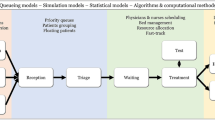Abstract
Patient queues are prevalent in healthcare and wait time is one measure of access to care. We illustrate Queueing Theory—an analytical tool that has provided many insights to service providers when designing new service systems and managing existing ones. This established theory helps us to quantify the appropriate service capacity to meet the patient demand, balancing system utilization and the patient’s wait time. It considers four key factors that affect the patient’s wait time: average patient demand, average service rate and the variation in both. We illustrate four basic insights that will be useful for managers and doctors who manage healthcare delivery systems, at hospital or department level. Two examples from local hospitals are shown where we have used queueing models to estimate the service capacity and analyze the impact of capacity configurations, while considering the inherent variation in healthcare.





Similar content being viewed by others
References
Gross, D., Shortle, J. F., Thompson, J. M., and Harris, C. M., Fundamentals of queueing theory, Wiley series, 2009.
Halstrøm, H. L., and Jensen, A., The life and works of A.K. Erlang. By E. Brockmeyer, Transactions of the Danish Academy of Technical Sciences, 1948 No. 2.
Kleinrock, L., Queueing systems: Volume I & II—Theory. Wiley Interscience, New York, 1975.
Green, L., Queueing analysis in healthcare, in Patient flow: reducing delay in healthcare delivery, Hall, R.W., ed., Springer, New York, 281–308, 2006.
Fomundam, S., and Herrmann, J. W., A survey of queuing theory applications in healthcare. Technical report, University of Maryland, 2007.
Worthington, D. J., Queueing models or hospital waiting lists. J. Oper. Res. Soc. 38(5):413–422, 1987.
Restrepo, M., Henderson, S. G., and Topalogu, H., Erlang loss models for the static deployment of ambulances. Health Care Manage. Sci. 12:67–79, 2009.
McManus, M. L., Long, M. C., Cooper, A., and Litvak, E., Queueing theory accurately models the need for critical care resources. Anesthesiology 100(5):1271–1276, 2004.
Green, L., How many hospital beds? Inquiry 39:400–412, 2002. Winter 2002/2003.
Bagus, A., Place, M., and Posnett, J. W., Dynamics of bed use in accommodating emergency admissions: stochastic simulation model. BMJ 319:155–158, 1999.
Teow, K. L., Practical operations research applications for healthcare managers. Ann. Acad. Med. Singapore 38:564–566, 2009.
Teow, K. L., Chia, Y.P., Tan, H. H., Zhu, Z., Heng, B. H., A pure loss queueing model for endoscopy recovering bed planning. NHG Annual Scientific Congress 2009. 16–17 Oct 2009.
Palvannan, R. K., Teow, K. L., Zhu, Z., Heng, B. H., Estimating impact of service partitioning with demand variability using queueing theory. NHG Annual Scientific Congress 2009. 16–17 Oct 2009.
Acknowledgements
We thank Ms Grace Chiang (Director Operations, National University Hospital), Sister Y P Chia and Sister H H Tan (Tan Tock Seng Endoscopy Centre) for permission to use their data.
Author information
Authors and Affiliations
Corresponding author
Rights and permissions
About this article
Cite this article
Palvannan, R.K., Teow, K.L. Queueing for Healthcare. J Med Syst 36, 541–547 (2012). https://doi.org/10.1007/s10916-010-9499-7
Received:
Accepted:
Published:
Issue Date:
DOI: https://doi.org/10.1007/s10916-010-9499-7




